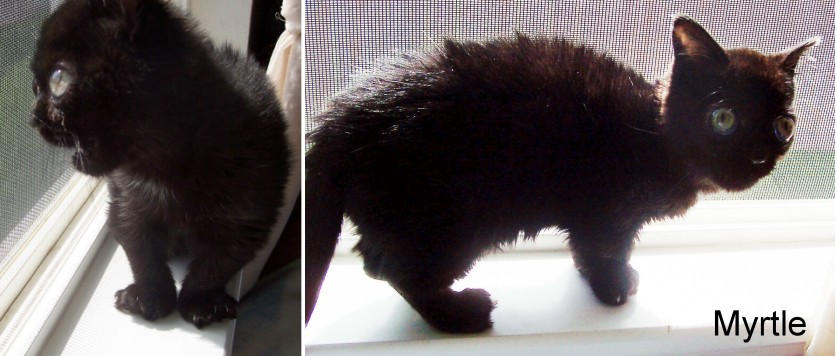
LYSOSOMAL STORAGE DISEASES (LYSOSOMAL STORAGE DISORDERS) AND FADING KITTENS
There are several reasons that kittens fail to thrive, fade and die during their first few weeks. Blood group mismatch (where maternal antibodies from colostrum attack the kittens red blood cells), cleft palate and serious infection are probably the best known. Lysosomal Storage Diseases (LSDs) are less well known to breeders and rescuers and cause much heartache as they are generally fatal, regardless of the effort put into trying to get a kitten to gain weight like its littermates.
LSDs are metabolic disorders that affect the function of lysosomes – the part of the cell that recycles chemicals. LSDs cause an accumulation of various substances that would usually be eliminated by the enzymes, and which instead become stored in the cat’s tissues in abnormal amounts. As a result, the cells swell and can no longer function normally, so that the affected organs can’t function correctly. The liver, which normally processes toxins, becomes enlarged. Most LSDs affect the nervous system and cause degenerative neurological disorders. They can also cause stunted growth and abnormal features. Almost all LSDs in cats are fatal and an affected kitten (if not stillborn) deteriorates within weeks or months. Those with a milder form of LSD survive longer, but have special needs.
Although most LSDs are fatal when a cat inherits 2 copies of the mutated gene, cats with one mutated gene and one normal copy may show mild clinical symptoms which means they can be removed from a breeding programme.
12 different Lysosomal Storage Diseases have been described in cats. There are certainly many more cases than described in the literature because most owners don’t have the resources for expensive veterinary tests, let alone DNA analysis. In many cases the symptoms and progression indicate an LSD, though it will never be known exactly which LSD. Below are some case studies, followed by brief summaries of several different LSDs.
MYRTLE
Cherisse from Idaho, USA, provided these photos of Myrtle, a 3 month old black female kitten with apparent midgetism and Mucopolysaccharides 6. She has a minor cleft palate, nasal issues, weeping eyes, an undershot jaw and dwarfism in her front legs. She also has a cranial deformity with bulbous, protruding eyes. She is, nevertheless, active and happy and is on a semi-liquid diet due to her facial conformation.

TASHIA WHITE-SUMNER’S KITTEN
This account received from Tashia White-Sumner in March 2018 suggests one of the Lysosomal Storage Diseases. On February 15, 2018, Tashia’s daughter’s stray cat had a litter of six small kittens. The mother was inexperienced and needed human help. One kitten was absolutely tiny – about half the size of the others and looked unusual with an oddly shaped head – but was fully furred and didn't appear premature. She was tortie, the only “colourful” kitten in the litter. She didn’t start breathing until Tashia rubbed her chest to revive it. She remained the runt of the litter, not growing or filling out like her siblings. Tashia supplemented her feeds with KMR (Kitten Milk Replacer) and made sure she had some time alone with the mother cat in order to suckle. She did not gain weight, remaining drastically tiny and lethargic. At six days old, the whole litter was seen by the vet who suggested the kitten had a neurological or other organ issue and would be lucky to survive another two days. That night the runt stopped breathing but was revived with chest rubs, sugar water and KMR.
Every other day she would crash in the same way (this suggests she could not lay down any energy reserves). She would only take drops of formula at a time. She slowly grew in size but did not lay down any fat and remained just all skin and bones. At 9 days old she weighed 59g, which was much higher than her birth weight. On day ten she was up to 67g, but dropped back down to 63g and fluctuated a gram back and forth from day 11 until day 14, never weighing any heavier than 67g. Whiskers appeared on day 10, eyes opened on day 12, but she died on day 14.
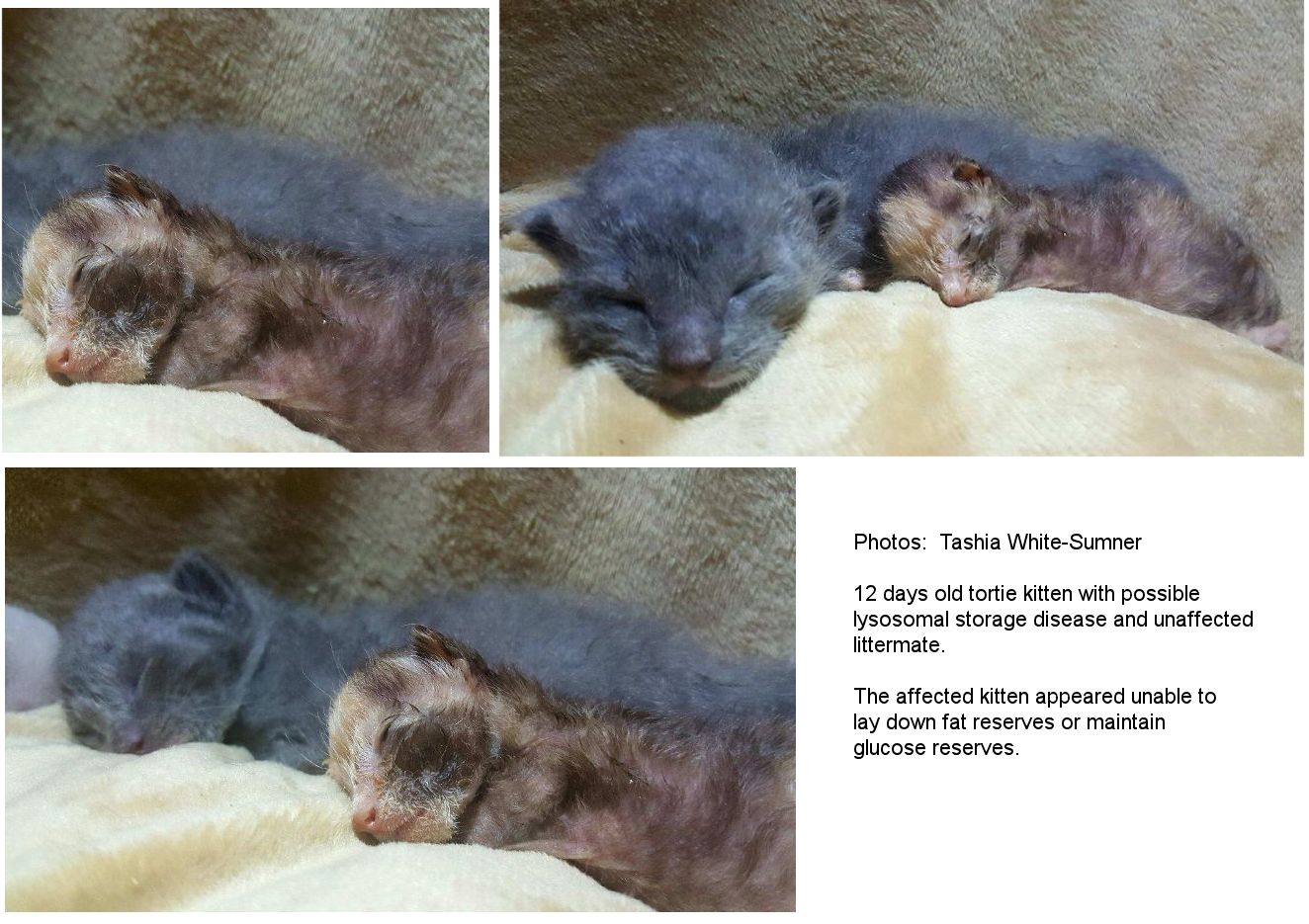
On day 12 the inexperienced mother broke the tip of the kitten’s tail which turned black but did not fall off before the kitten died. At this point the kitten received supplementary feeds every 30 minutes in addition to suckling from the mother cat and from another lactating cat. The vet still suspected neurological issues but could not perform any tests on such a tiny kitten. The kitten cried and was a fighter during her 14 day life, but could not maintain her own body temperature. Despite warmth and intensive care she died around midnight on the 14th day. She had been noted as being yellow that day when she was normally grey on her feet pads (jaundice, indicating liver problems, again a metabolic issue). Her abdomen had a dark spot that was not there previously and she was having regular bowel movements. A week previously, the side of her stomach had swollen while eating and then went back down; it never did this again.
The photos show her at 12 days old with her brother. Her brother is small for his age but the tortie kitten is only about half his size. The vet also suggested a possible placenta issue which would have caused her to waste away in the womb instead of receiving proper nutrition, but her inability to gain weight, maintain her own body temperature, lay down fat or store glucose, in combination with the oddly shaped head, indicates a metabolic disorder.
BUTTER BEAN
Butter Bean was one of 6 kittens born on 23-Mar-2023 to a pregnant female being cared for by cat rescuer and fosterer Candy Lusk Davis in Alabama. Two of the kittens died within 5 days after failing to gain weight. Of the four survivors, three gained weight in the normal way, but Butter Bean, an orange male, failed to thrive or gain weight despite Candy following fading kitten protocol: supplementary feeding (kitten milk replacer and semi-solids later on) and electrolytes. The graph shows how his weight peaked around 8 ounces before dropping again. During the same period, his littermates showed normal patterns of weight gain. Butter Bean also had a distinct pot belly (suggestive of an enlarged liver), quite different from the “full belly” seen in normal kittens.
Although he had periods of seemingly normal activity, he was less active than his littermates and liked to nap (particularly on a warm human). In short, he seemed to lack energy. Despite all these challenges, he was not unhappy, he ate and played, but he just got tired quickly. At the end he lacked enthusiasm for feeding as his body was simply unable to support his energy needs. He died on the night of 8-May-2023, aged almost 7 weeks, warm and loved, after refusing food.
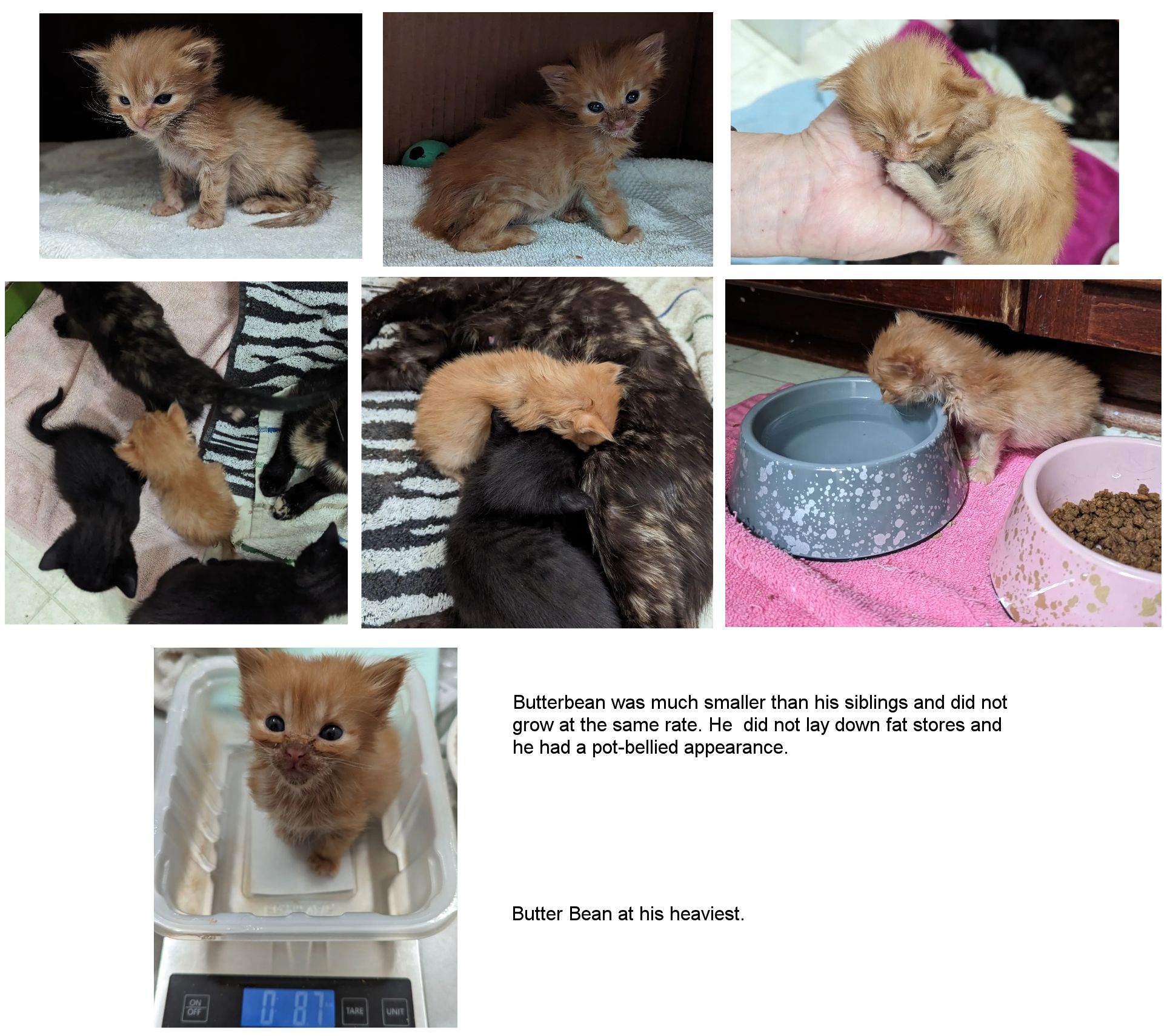
Because of the length of time getting DNA samples to a lab and a report back, LSDs are often only diagnosed post mortem. In Butter Bean’s case, even without DNA being analysed (something not cost effective for a rescue to do), his physical appearance, progress and symptoms are highly suggestive of one of the Lysosomal Storage Diseases. Because these diseases are due to recessive genes, he was probably the result of a brother-sister mating or a father-daughter mating.
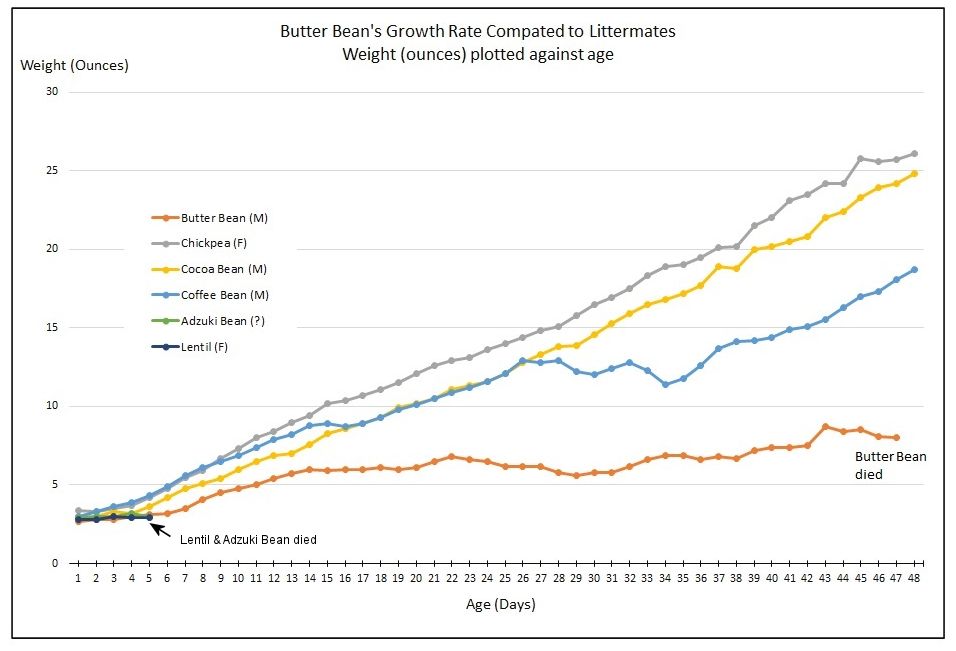
POSSIBLE MUCOPOLYSACCHARIDES 6 IN FERAL/STRAY COLONY
In August 2023, I received an email from Stacy regarding some dwarf kittens that were born in a feral/stray colony. They were 1 – 3 years old in 2023.
“I'm calling them dwarves because they start off super small and grow slowly with delayed physical milestones (eyes change color later, teeth appear later, lower muscle tone, take longer to learn to land on their feet when falling . . . Reggie has a recessed lower jaw that makes him look like he's pouting . . . Pumpkin still has to spread her front legs wide when she shakes her head or will fall over), but they're not super tiny now. They do still have unique facial features though. Especially as babies, they have larger/rounder heads, wider foreheads, bigger, wider set eyes . . . just a different look than the other cats. And if they're up on their back legs, they kind of look like a gummy bear because of the length of their legs to body (see photos of Pumpkin and Moji). They're more or less proportional now though. 3 of them are from our feral colony (and I think their moms are cousins), and 1 is from the surrounding neighborhood, but he has the same features. He's not related as far as I know.
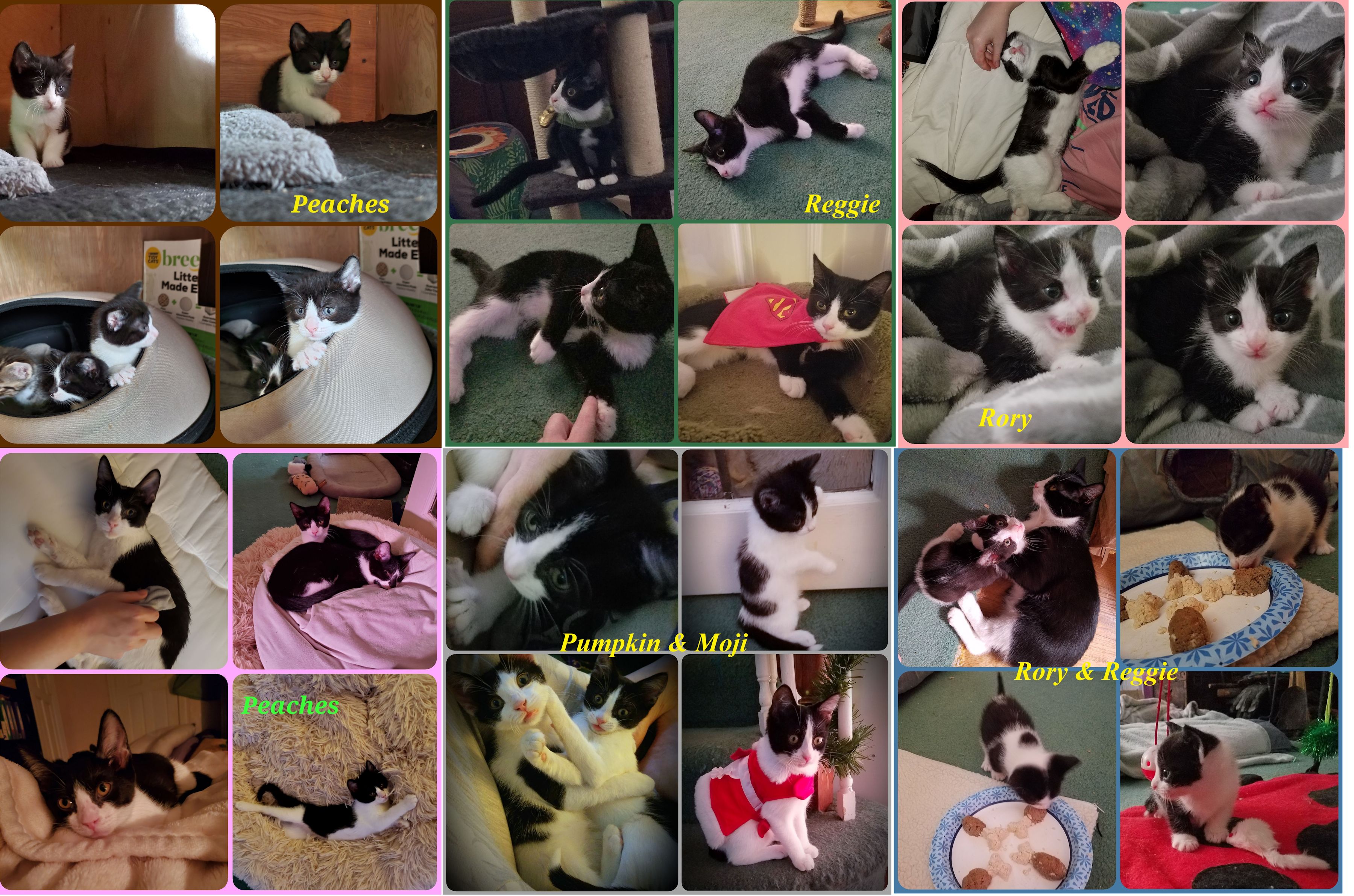
I also have 2 siblings of the dwarves that are not small and don't have the facial features, so "normal" I suppose, but they both have the same odd/stilted walk where it looks like they kind of move their back legs from the hips instead of bending their legs. The dwarves don't have this walk, but the 2 siblings do. These 2 siblings were the ones who were watching over and attached to their dwarf sibling, which is why I adopted them as well.
I don't see any dwarfism features in the mothers or the suspected fathers. I also have not noticed any other dwarves, and I don't think any other siblings were affected in any of the multiple litters. A separate mom in the colony has had multiple stillborn litters, but her one viable litter doesn't show any problems. And the mothers and fathers have bred in different combinations that have led to dwarves and non-dwarves. I have a sort of family tree sketched out if it would be helpful. (And everyone is finally spayed and neutered now!)
I'm attaching some photos of each of them as babies and more recent. Pumpkin is a dwarf, and Moji is her "normal" brother (mom - Oreo). Rory is a dwarf and the older brother of both Peaches, who is a dwarf, and Rocki, who is "normal" (mom - Shadow). Reggie is the dwarf we adopted from the neighborhood. Pumpkin is the most affected for sure. And Reggie has lost some of the features as he has grown. I've also noticed that they have dichroic eyes. Pumpkin, Moji, and Peaches have yellowish eyes with a blue ring around the pupil. Reggie has yellow eyes with a darker butterscotch colored ring around the pupil. Not sure if that's related or just an interesting genetic quirk in the group, but it's pretty! Also, the herpes virus has been rampant in the area cats for the past few years, but I would think more of the kittens would be affected if it was the cause. “
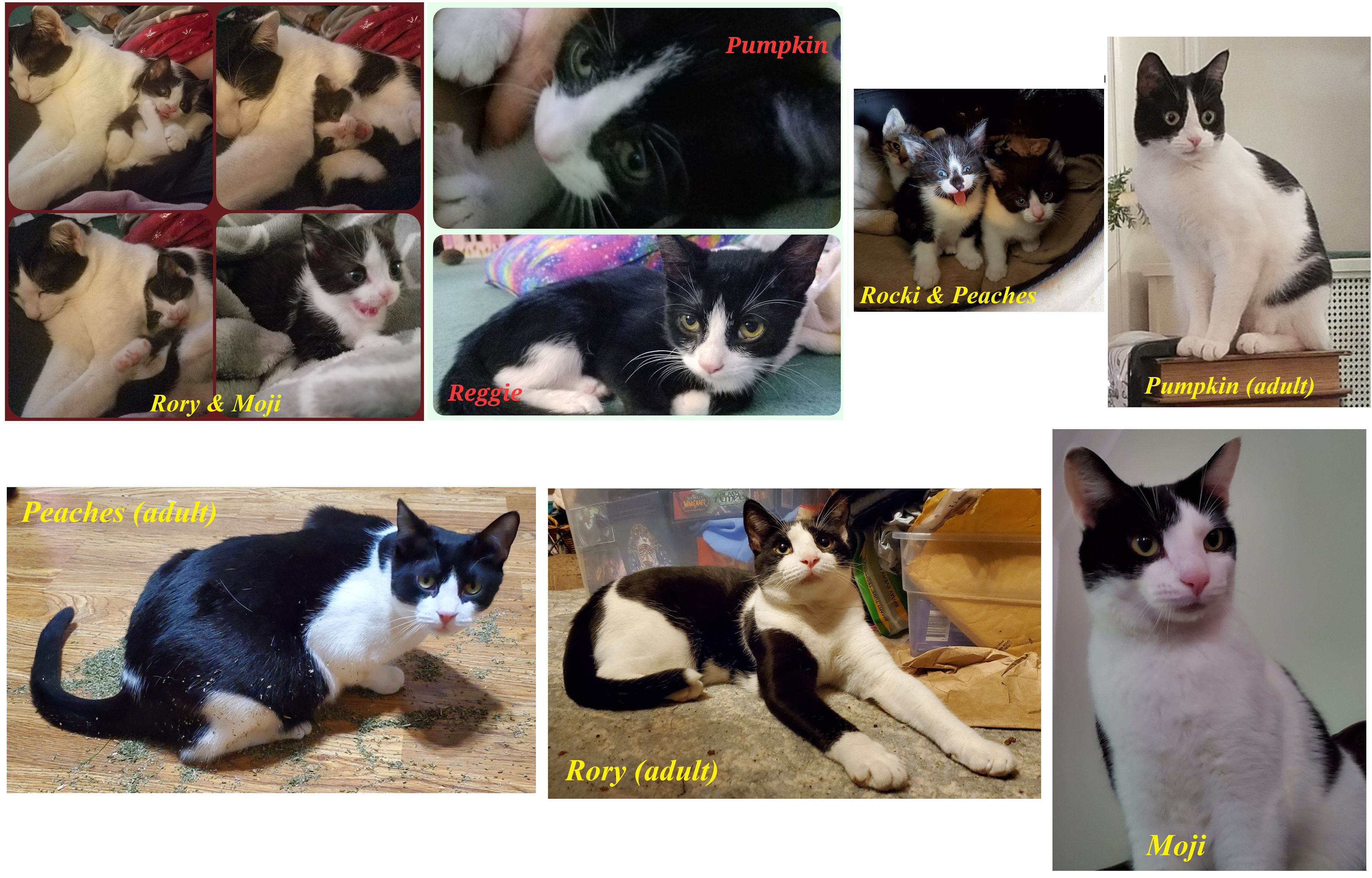
It's impossible to be sure of anything except that inbreeding has caused some recessive genes to surface. Based on the descriptions and photos, it could be one of the lysosomal storage diseases, but a mild type. There is a mild form of Mucopolysaccharidosis 6 (MPS VI) that seems to match Stacy’s observations, and which can affect growth and facial proportions but not impact life quality or expectancy. However, there are also other similar diseases and mutations in cats that haven't been studied yet, so this is only a best guess.
There is a general description of Mucopolysaccharidosis 6 (MPS VI) below. The mild form is considered very widespread.
KNOWN LYSOSOMAL STORAGE DISEASES IN CATS
This is not an exhaustive list. Some diseases are associated with particular breeds, but may also be seen in random-bred domestic cats.GANGLIOSIDOSIS
Gangliosides are vital for normal brain cell function. There are two types of Gangliosidosis relating to which ganglioside (GM1 or GM2) accumulates in lysosomes. The symptoms are similar, but they are due to separate mutations. GM1 shows up later and progresses more slowly than GM2.
GANGLIOSIDOSIS GM1
Behaves as autosomal recessive; seen in Siamese, Korat and related breeds.
This enzyme deficiency can also be detected in heterozygous cats so that carriers are not bred from. It is caused by a mutated GLB1 gene. It is a degenerative disease of the brain and spinal cord due to the deficiency of the enzyme beta-galactosidase. Early signs are head tremor and hind limb tremor at 2-3 months old; high-stepping gair, ataxia and flickering eye movements. By 8 months, the cat usually cannot stand up. By 12 months there are seizures and loss of vision. Kittens are stunted with poor appetite and a flat broad head with small ears. This progresses to hind-limb weakness, depression, dementia, seizures, aggression and death at a young age.
GANGLIOSIDOSIS GM2 (TAY SACHS/SANDHOFF'S DISEASE)
Autosomal recessive, seen mostly in Korat and Burmese
This enzyme deficiency may be detected in heterozygous carriers of the gene so that carriers are not bred from. A degenerative disease of the nervous system caused by a deficiency of the enzyme beta-hexosaminidase. It shows up earlier and progresses faster than GM1. Begins with head tremor at 6-10 weeks, uncoordinated movement, falling and finally seizures. The head is unusually rounded and the cornea of the eye is slightly opaque. In Korats Gangliosidosis GM2 is due to lack of hexosaminidase A and B, resembling Sandhoff’s disease, due to mutated HEXB gene. A different HEX B mutation causes GM2 in domestic longhairs.
GLOBOID CELL LEUKODYSTROPHY (GALACTOSYLCERAMIDE LIPIDOSIS, KRABBE DISEASE)
Possibly autosomal recessive
Kittens with globoid leukodystrophy develop a tremor, weakness and lack of coordination of the back legs at around 5-6 weeks. The poor coordination progresses to the forelegs due to degenerative changes in the brain. By about 12 weeks the hindlimbs become rigid and straight and the cat cannot empty its bladder. By around 15 weeks there is hindlimb paralysis and by 21 weeks respiratory problems lead to death.
GLYCOGENOSIS TYPE II (GLYCOGEN STORAGE DISEASE II)
Undetermined mode of inheritance. This causes poor growth, incoordination, muscle weakness and eventual recumbency and death due to deficiency of alpha-glucosidase.
MANNOSIDOSIS ALPHA (a-MANNOSIDOSIS)
Autosomal recessive, seen in Persians.
An alpha-mannosidase enzyme deficiency that affects the central nervous system. This results in accumulation of large sugar molecules in the brain, kidney and liver. Most affected kittens are either stillborn or die at birth. Those that survive usually show symptoms during the first few days or weeks. Symptoms are general apathy, inability to stand properly and diarrhoea, progressing to tremor and incoordination. The voice becomes weaker and an enlarged liver causes a swollen belly. There may be bizarre behaviour/dementia, corneal and lens opacification and retarded growth, ending in premature death. Age of onset and rate of progression of symptoms are variable reflecting a variable degree of enzyme deficiency.
MUCOLIPIDOSIS II (I-CELL DISEASE)
Autosomal recessive
Mucolipidosis II is caused by a mutation of the GNPTAB gene. There are abnormal facial features, retarded growth, large paws, poor growth and progressive hind-limb paralysis. Other traits are flat, broad face, hypertelorism (abnormally wide-set eyes), frontal bossing, small ears, thickened upper and lower eyelids. Dilated pupils and retinal degeneration lead to blindness. There is thickened skin, especially on the back of the neck. Severely deformed spinal column, fused vertebrae, hip dysplasia, abnormally shaped skull and generalised decreased bone opacity. It is differentiated from mucopolysaccharidosis by blood and urine tests. Affected cats die within the first few days to first 7 months of life, often due to upper respiratory disease or cardiac failure.
MUCOPOLYSACCHARIDOSIS 1
Autosomal recessive.
This enzyme deficiency causes grossly abnormal neurons in the brain and spinal cord. The facial profile of affected cats is altered: short, broad nose, depressed nasal bridge, prominent forehead, small ears and opacity of the cornea. The affected cat sits crouched with spread forelegs. The cervical vertebrae are unusually wide, asymmetrical and frequently fused. The breast-bone (sternum) is unusually concave. An enlarged liver and spleen may cause a swollen belly. Though the gene behaves as a recessive (lethal in homozygous cats), the enzyme deficiency can also be detected in heterozygous cats, allowing carriers to be screened out of breeding programmes.
MUCOPOLYSACCHARIDOSIS 6
Impairing rather than lethal, autosomal recessive seen in Siamese
LSD due to an enzyme deficiency; can be treated using bone marrow transplants. Affected cats have slow growth, a short, broad nose, depressed nasal bridge, widely spaced eyes and small ears. The face has a flattened appearance. The eyelids appear to be narrow, the upper lid is swollen and drooping. The cornea of the eye is slightly opaque. The vertebral column is deformed, especially the cervical, thoracic and lumbar regions. Signs evident from 6-8 weeks as the kitten adopts a crouching gait. Joints may be painful and hindlimbs weak due to compression of the spinal cord within the backbone. Bony changes progress until around 9 months old and may stabilise. There are changes within major organs and white blood cells. The enzyme deficiency can be detected in heterozygous cats, allowing carriers to be screened out of breeding programmes.
There are 2 forms of Mucopolysaccharidosis VI (MPS VI) in cats: the more severe L476P mutation identified in cats from Italy and North America and the milder, very widespread D520N mutation. These are inherited independently of each other. L476P homozygotes have dwarfism and facial dysmorphia. D520N (MPS VI Mild) homozygotes have normal growth and appearance and are unaffected by disease UNLESS they also carry the L476P (MPS VI Severe) mutation. Cats with one D520N and one L476P have normal growth and appearance and only mild MPS VI signs.
MUCOPOLYSACCHARIDOSIS 7
Autosomal recessive
Observed in 2 feral kittens from an inbred colony in California. Cause stunted growth, short limbs, paralysis of limbs, fusion of bones, clouded eyes, tendency to upper respiratory infections and early death (in the 2 reported cases, one died aged 21 months, one at 7 months). It has also been reported in a domestic shorthair cat in Switzerland and in in Michigan, USA. A further case occurred in Trenton, Ontario. A 3-month old, female farm kitten presented with weakness in her rear legs. Compared to an unaffected littermate, she was small for her age, had a rounded head, hollow chest and hind limb paralysis. She was not in pain and pulled herself along with her forelegs. By 6 months old all four limbs were paralysed and her corneas became opaque. X-rays found spinal abnormalities and enlarged organs. Diagnosis was MPS VII, but analysis found it to be a new spontaneous mutation.
NEURONAL CEROID LIPOFUSCINOSIS
Mode of inheritance not yet determined.
This LSD has been seen in Siamese and causes progressive degeneration of the brain, blindness (with retinal atrophy) and seizures. Ceroid-lipofuscin pigment is deposited within neurons of the central and peripheral nervous systems. Unlike the human form, neuronal ceroid-lipofuscinoses, pigment deposition appears restricted to neural tissues.
SPHEROID LYSOSOMAL DISEASE
Autosomal recessive seen in Abyssinian
The cause is anomalous tissue occurring in the central nervous system. Initial symptoms are exhibited around 8-12 weeks old. A tremor progresses to head-nodding and swaying of the body. Movement is slow, clumsy and the kitten falls often. The sense of direction is impaired and the cat may have seizures when handled. The appetite is normal, but feeding is messy due to increasing tremor.
SPHINGOMYELINOSIS (SPHINGOMYELIN LIPIDOSIS, NIEMANN-PICK DISEASE, TYPE C)
Autosomal recessive seen in Siamese
This LSD manifests as a nervous disease and signs are seen from 3-4 months old. Affected kittens lose interest in their surroundings, lose their appetites, develop a tremor, poor balance and later ataxia. Other signs can include splayed legs, high-stepping walk, plantigrade stance (hock-walking) and moderate enlargement of the liver and spleen. Sometimes there is stereotypic chewing. There is progressive paralysis and most cats die before 1 year old. Although inherited as a recessive trait, heterozygous cats can be detected by biochemical analysis and screened out of breeding programmes.
A variant form with mild or no central nervous system signs has been seen in Siamese cats: a 6 month old Siamese with ataxia and head tremor was possibly reported as neurovisceral sphingomyelinosis. It occurred in siblings, but the mode of inheritance was unknown. One sibling died after exhibiting symptoms.